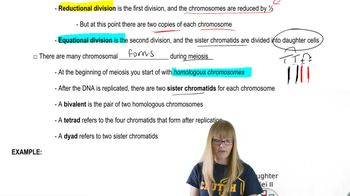Here are the essential concepts you must grasp in order to answer the question correctly.
Chromosome Number and Meiosis
Chromosome number refers to the total number of chromosomes in a cell. In meiosis, homologous chromosomes pair up and segregate into daughter cells. In the case of the sterile hybrid between Secale cereale (14 chromosomes) and Elymus canadensis (28 chromosomes), the mismatch in chromosome numbers leads to difficulties in pairing during meiosis, resulting in no homologous chromosomes aligning at meiosis I.
Recommended video:
Hybrid Sterility
Hybrid sterility occurs when the offspring of two different species are unable to reproduce. In this case, the hybrid between Secale and Elymus is sterile because the differing chromosome numbers prevent proper pairing and segregation during meiosis, leading to gametes that lack the necessary genetic material for successful reproduction.
Recommended video:
Anaphase I and Chromosome Separation
Anaphase I is the stage of meiosis where homologous chromosomes are pulled apart to opposite poles of the cell. In the sterile hybrid, since no chromosomes pair during meiosis I, the separation pattern would involve random movement of unpaired chromosomes, leading to an unequal distribution and potentially resulting in gametes with varying and incomplete sets of chromosomes.
Recommended video:






